|
Electro-Encephalo-Graphy (EEG)
|
|
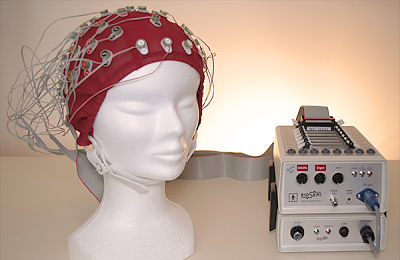
|
LEAD has acquired, thanks to a grant from the Burgundy Regional Council (Conseil
Régional de Bourgogne), a 64-channel Biosemi recording system, along with BESA
software to analyse the EEG data that will be collected. (We also will use the
Matlab toolbox, EEGLAB, http://sccn.ucsd.edu/eeglab/, for EEG data analysis).
EEG equipment allows the recording of the electrical activity of the human
cerebral cortex by placing sensors on the scalp. The procedure is completely
non-invasive and painless. The EEG signal allows precise temporal resolution in the
millisecond range and, for this reason, it is particularly well adapted for
time-course and neural studies of cognitive processes that occur in time periods of
less than 1 second. |
|
|
|
Eye-tracking
|
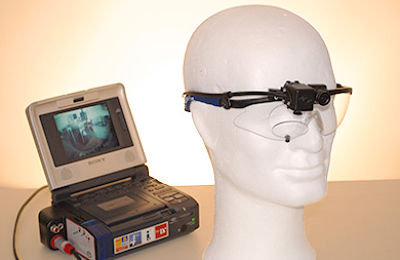 |
Eye-tracking plays a significant role in much of the research carried out at LEAD.
This technology is used to perform on-line recording of vision-based learning
activities. Eye-tracking involves recording fixation points and saccades during a
task, such as reading, viewing a visual scene, etc. Eye-movement path of a
participant during learning of a complex mechanical system (operation of the hammer
mechanism from an upright piano, from Boucheix et al., 2010)
The eye-tracking parameters used depend on the requirements of the experiments
being carried out. The parameters which can vary are:
- sampling rate: 50, 120, 350, 500, and 1000 Hz.
- the type of equipment: head gear or glasses worn by the participant
(e.g., Mobile eye) or remote systems (Tobii, ASL, EyeLink).
- the means of recording used: corneal reflection capture (Tobii, EyeLink) or image
analysis (FaceLAB).
|
|
|
|
Near InfraRed Spectroscopy (NIRS)
|
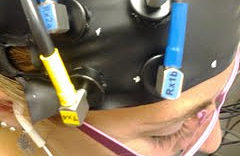 |
Near InfraRed Spectroscopy is a technique which involves measuring the oxygenation
of a brain region, through the absorption of light in the bloodstream. It is a
recently developed measure which enables ‘optical imaging’ for research in
psychology (see Ferreri, Bigand, Perrey, & Bugaiska, 2013). The general principle
of NIRS is to compare the difference in light absorption in the brain with several
different sensors. Different levels of oxygen in the blood result in different
levels of light absorption, and thus one can measure the changes in blood
oxygenation supplying the neurons at play in any particular task, for instance the
activity of a population of neurones according to whether a stimulus is present or
absent. NIRS allows us to look at the brain in real time, during a cognitive task.
It gives a dynamic measure and is quick and non-invasive in its operation. As such,
NIRS permits us to measure brain activity and the neural substrates of deficits in
a variety of populations who are less mobile, such as new-borns, older adults,
pathologies such as Alzheimer’s disease, deaf children, or people who have had a
stroke.
|
|
|
|
Physiological Measures
|
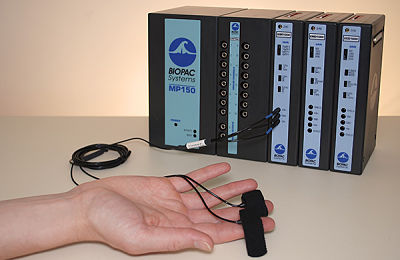 |
For studies involving emotions or conditioning, LEAD is equipped with a Biopac
system.
This system allows various physiological data to be collected such as
electrocardiograms, EMGs, or electrodermal response data.
|
|
|
|
Audio equipment
|
 |
LEAD has a complete facility designed for the study of musical cognition and emotion.
Psychoacoustical studies are carried out in small double-walled anechoic chambers
(90 dBA sound insulation) or larger single-walled chambers (60 dBA sound
insulation).
The study of emotions generated by music is done in a sound immersion
studio with a 5.1 Audio system that allows highly realistic reproduction of music as
it would be heard at a concert. The facility is also used in studies on sound
spatialization in which listeners must learn the rules of sound source movements with
which they are presented. Finally, musical performance and sight-reading is currently
being carried out with a Yamaha midi piano with an integrated eye-tracking system.
|
|
|
|
Optical equipment
|
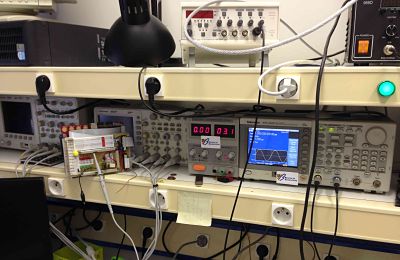 |
The laboratory carries out experiments in vision on human participants, and also on
neuro-inspired artificial retinas. Articifical retinas enable the study of vision
whilst controlling for and measuring physical parameters (such as the precise light
source, monochrome or colour, photometric measures, optical-electronic
measures, etc). The specifications for the optical experimental set-up is:
- Anti vibration table
- Motorised turntable for movements in X and Y
- Stable light source
- LED lighting
- Camera optics
- Photometric and spectrographic meters
For the electronic workshop
- Oscilloscope 500 MHz, 4 analogue channels and et 16 logical channels
- Signal generator 100 MHz
- Counter 2 x 300MHz
- Table multi-meter
|
|
|
|
NAO Robots
|
 |
Our research work on neuro-inspired systems has the aim of proposing neural models
models which mimic the function of the brain in cognitive tasks. Our neural models
are developed in ways which mean they can be embedded into autonomous systems
and interactive robots. For example, with our neuro-inspired systems we can control
robots through hand gestures or through the recognition of human facial
expressions.
|






